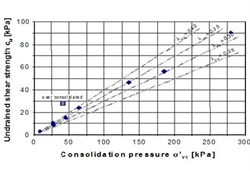RESULTS
The first stage of evaluating the critical state of the used Kaolinit soil, was the examination of triaxial compression tests. Fig. 2: shows the undrained shear strength against the consolidation pressure before shearing. Fig. 3: Shows the deviatoric stress at the critical state against the mean effective stress. The results show that even under very low stresses at the border to the liquid consistency, the soil is showing a measurable undrained strength.
Results from the angle of friction successfully support the critical state theory that is successfully applied in the mechanics of stiffer soils for decades.
The soil viscosity is tested during undrained shearing, by evaluating the deviatoric stress response during a stepped axial strain test (jump test). Results from several tests can be seen in Fig. 4. The viscosity index measured during the undrained shearing is increasing for low consolidation pressures. When carrying out drained tests under low effective stress, the soft soil was contracting stronger and the number of particle contacts was increasing while shearing. Therefore the soil viscosity expressed by the viscosity index is well below that of the values measured in the undrained shearing tests.
During the triaxial compression test, a phase of stress relaxation was included. While the axial strain is held constant, the deviatoric stress was reduced 20% over a 40 hour period, see Fig 5. The graph emphasises the importance of taking the viscosity of soft soils into account when assessing foundations. The results show that soil resistance after stress relaxation is higher than in the shearing phase before the relaxation phase. This is interesting because the rate of deformation is twice as slow in the shearing phase after relaxation, compared to the shearing phase before relaxation. The structure is capable of carrying higher deviatoric stresses during further shearing. However, the structure is somehow destroyed when enough shear strains are applied on the soil sample and the deviatoric stress is decreased between jump 4 and 5 in the left diagram of Fig. 5: At high shear strains the additional strength gained during soil relaxation vanishes as given in Fig. 5: where the curve (6,8 ∙ 10-4 %/min) after jump 5 is on the same path as the one that may be extended from the curve between jump 2 and 3 (6,6 ∙ 10-4 %/min). | 
Fig 2: Undrained Shear Strength Vs Consolidation before Shearing

Fig 3: Deviatoric stress at the critical state against the mean effective stress Fig. 4 Drained and undrained viscosity consolidation results
Fig 5: Deviatoric Stree was reduced 20% over a 40 hour period |